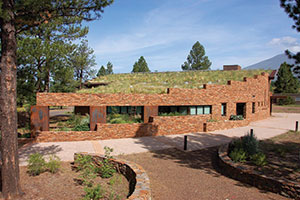 “Green walls” date all the way back to the Babylonians. One historical example is known as one of the seven wonders of the world—the Hanging Gardens of Babylon. The name green wall refers to “vertical gardens” or “living walls,” and is used to describe all vegetated wall surfaces. According to greenscreen.com, green walls can be broken into two categories—green facades and living walls.
“Green walls” date all the way back to the Babylonians. One historical example is known as one of the seven wonders of the world—the Hanging Gardens of Babylon. The name green wall refers to “vertical gardens” or “living walls,” and is used to describe all vegetated wall surfaces. According to greenscreen.com, green walls can be broken into two categories—green facades and living walls.
Green facades
Green facades include more climbing or self-clinging plants, or cascading groundcovers that are directed to cover certain structures. Plants are rooted at the base of the structure and they grow up and over, and sometimes around, the structure. Where you might have your own facades of English ivy growing up your home, new technology such as modular trellis systems, cables, and netting provide landscape architects creative outlets for these types of plants to install “living architecture,” even on the biggest structural eyesores.
Living walls
Living walls not only add a natural aesthetic effect to any vertical structure, but they provide a habitat for a variety of animal and plant species, and encourage positive change within a community throughout the seasons. For public spaces, living walls can reduce the heat island effect, improve exterior and interior air quality, contribute to noise reduction, and provide thermal insulation. If you are considering including a living wall in your home or office, work with a local gardener or landscape designer to discuss the types of plants and look you desire for the space.
Green Roofs
Green roofs are becoming more common in the United States and high-rise buildings aren’t the only structures that can have a garden in the clouds—apartment complexes, libraries, hotels, and even the post offices are adding rooftop gardens to their designs. The push for urban greening is not only catching the attention of commercial builders, but is also shown to provide opportunity for social, economic, and environmental benefits to the general public, according to greenroofs.org.
Energy conservation is one of the main benefits of green roofs, as they provide a roofing membrane and naturally cool the floors below. Additionally, the inviting, natural aesthetics of the roofs cause people to gravitate to the environment, where they can learn about the benefits or simply enjoy the space, whether it be a community garden, playground, art appreciation center, or commercial space.
For energy-savings in the warmer months, “depending on the plants and depth of growing medium, green roofs retain 70-90% of the precipitation that falls on them; in winter they retain between 25-40%,” according to greenroof.org.
Roofs also contribute to improved air quality as the plants reduce dust particles in the air, pollutants, and CO2. Economically, they help create jobs for the manufacturing of products, landscape architecture and design, installation needs, and maintenance of the grounds.
Adding greenery to any structure or environment contributes to a larger purpose of cleaner air, improving the aesthetics of the community and creating opportunities for people to come together.






I have been hearing more and more about these green roofs especially. They sound like an interesting concept, especially when it comes to increasing the levels of air purity in the places where they are installed. I would love to see one somewhere soon!